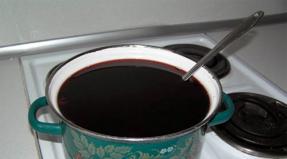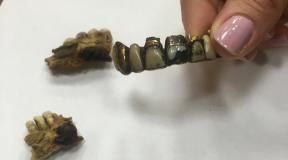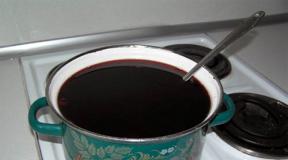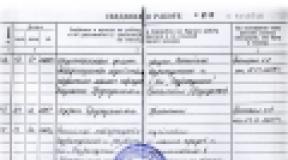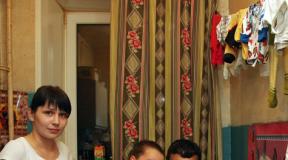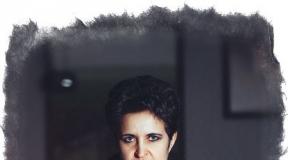Vestibular dysfunction of vascular origin. Vestibular syndrome causes, symptoms, treatment and prevention methods Acute vestibular syndrome
The vestibular system helps maintain a sense of balance and spatial orientation, provides information about head position, and records images on the retina. Vestibular disorders (vestibular syndrome) can cause dizziness, confusion, and instability (a feeling of movement or rotation of the body, although the person is standing or lying down). Vestibular disorders may also cause nausea, vomiting, diarrhea, restlessness, or changes in blood pressure or heart rate.
Vestibular disorders can be caused by certain diseases, medications, or problems in the inner ear or brain. Many people experience problems with their sense of balance as they age. Vestibular disturbances and dizziness can also occur as a result of taking certain medications.
The sense of balance is primarily controlled by the labyrinth, a structure in the inner ear. One part of the labyrinth consists of the semicircular canals and otolithic receptors responsible for the balance of the body. On the other side there is a cochlear organ responsible for hearing. The parts of the inner ear associated with balance are called the vestibular apparatus. The vestibular system works in conjunction with other sensorimotor systems in the body, such as the visual system and the musculoskeletal system, to control and maintain body position at rest or in motion. It also helps maintain focus on a specific object even if the body's position changes. The vestibular system does this by recording mechanical forces, including gravity, that act on the vestibular organs during movement. Two parts of the labyrinth help solve these problems: the semicircular canals and the otolithic apparatus.
The semicircular canals are three fluid-filled loops located approximately at right angles to each other. They tell the brain when the head makes movements, such as when a person nods his head up and down or turns his head to the right or left. The visual system works in conjunction with the vestibular system to ensure that visual images do not blur when the head moves, such as when walking or riding in a car. Sensory receptors (proprioceptors) in joints and muscles also help maintain balance when standing or walking. The brain receives, interprets and processes information from these systems and thus controls the balance of the body.

The vestibular structures of the inner ear consist of the vestibule (oval and round sacs) and three semicircular canals. These structures work on the level principle used by carpenters. There are a number of diseases of the structures of the inner ear that lead to disruption of the functioning of these structures or the brain receives unreliable information from the receptors of these structures. These conditions include Meniere's syndrome, labyrinthitis, benign paroxysmal positional vertigo, middle ear infections, tumors, or trauma.
The most common causes of vestibular syndrome.
Benign positional vertigo considered the most common type vestibular syndrome and dizziness syndrome.
Benign paroxysmal positional vertigo, or positional vertigo, is a brief, intense episode of dizziness that occurs due to a specific change in head position. In the presence of such PH, dizziness may occur when lifting the head up or turning the head. An episode of such dizziness can occur even when turning over in bed. It is believed that the cause of this type of dizziness is a violation in the structure of the semicircular receptors, which send unreliable information about the position of the head to the brain, which is the cause of the symptoms. The cause of benign paroxysmal positional vertigo (BPPV) can be head trauma, neuritis, and age-related changes. The disorders are believed to be associated with an abnormality in the interaction of the photocopy with the cupula within the membranous labyrinth, resulting from abnormal responses to endolymph movement during head movement.
Labyrinth infarction results in sudden significant loss of auditory and vestibular function, and usually occurs in elderly patients. This condition sometimes occurs in younger patients with atherosclerotic vascular disease or the presence of hypercoagulable phenomena. Episodic dizziness can be a harbinger of complete occlusion and occur as a transient ischemic attack. After complete occlusion, the intensity of dizziness gradually decreases, but a certain instability during movement may persist for several months until vestibular compensation occurs.
Vestibular neuronitis. Nerve damage is associated with viral infections (herpes virus). The disease usually occurs in the autumn-spring period during the peak of acute respiratory infections. With vestibular neuronitis, episodes of dizziness occur without hearing loss and may be accompanied by nausea and vomiting. The duration of the episode can vary from several days to several weeks, with gradual regression of symptoms. Vestibular neuronitis may be accompanied by attacks of benign positional vertigo.
Labyrinthitis
Labyrinthitis is caused by an inflammatory process within the membranous labyrinth, which can be caused by a bacterial or viral infection. Labyrinthine viral infections cause symptoms of vertigo similar to vestibular neuritis, but in association with cochlear disturbances. Infections such as measles, rubella, and cytomegalovirus, as a rule, do not cause vestibular disorders. Bacterial labyrinthitis can be either with damage to the membranous labyrinth itself or in a serous form. The serous form of labyrinthitis is often observed in acute otitis media, when bacterial toxins diffusely enter the labyrinth.
Meniere's disease
Meniere's disease is a disorder of the inner ear and is characterized by episodic attacks of dizziness, sensorineural hearing loss, tinnitus, and a sensation of pressure on the ear membranes. First, hearing loss occurs at low frequencies, with gradual progression of hearing loss at other frequencies as episodes of the disease are repeated. Episodes of Meniere's disease?? characterized by true dizziness, usually with nausea and vomiting, and lasts for several hours. This disease is believed to be associated with expansion of the endolymphatic space, with ruptures and subsequent regeneration of the membranous labyrinth.
Migraine
Often, migraine attacks can be similar to attacks of Meniere's disease. But with migraine, hearing loss is less common than with dizziness, tinnitus, photophobia, and phonophobia. But, nevertheless, with migraine there may be a certain sensorineural hearing loss for low-frequency sound vibrations. Therefore, sometimes the differential diagnosis between these diseases is sometimes difficult. Multiple sclerosis also poses a diagnostic challenge in the differential diagnosis from migraine. In 5% of cases, multiple sclerosis may begin with debilitating dizziness, and in 50% of patients with multiple sclerosis, episodes of dizziness occur during certain periods of the disease. Moreover, one in ten patients with multiple sclerosis may have hearing loss, which can be partial or complete, which makes the symptoms similar to Meniere's disease or migraine.
Discharge disease»
Attacks of dizziness occur after disembarkation and the person continues to experience a swaying motion that persists after returning to a stable environment after prolonged exposure to motion (for example, after traveling on a train, car, or boat).
Other causes of vestibular syndrome. Damage to the vestibular analyzer can be caused by head trauma, whiplash injury, acoustic neuroma, drug intoxication following ear surgery, diseases of the musculoskeletal system (with impaired proprioception), diseases of the central nervous system.
Symptoms
When the vestibular analyzer malfunctions, a sensation of rotation occurs. A person may stagger when trying to walk or fall when trying to stand up. Main symptoms of vestibular syndrome are:
- Dizziness or feeling dizzy
- Falling or feeling like you might fall
- Weakness
- Blurred vision
- Disorientation
Other symptoms include nausea, vomiting, diarrhea, changes in heart rate, blood pressure, fear, anxiety, or panic. Some patients may experience fatigue, depression, and difficulty concentrating. Symptoms may come and go over a short period of time or have long periods between attacks.
Diagnostics
Diagnosis of vestibular disorders is quite complex, since there are many causes of vestibular dysfunction, both diseases and medications that cause dizziness. However, first of all it is necessary to consult an ENT doctor. After studying the medical history and a detailed study of the symptoms, the doctor will examine the ear and prescribe the necessary examination plan. The examination plan may include both laboratory studies or special tests (audiometry, electronystagmography), and neuroimaging methods such as MRI and CT. In addition, in recent years, research methods such as computer-dynamic visual test, vestibular autorotation testing, and VEP (vestibular-evoked potentials) have become widespread.
The simplest and most accessible tests are energy tests, which involve applying cold or heat to the middle ear, which is easiest to do using water of different temperatures. A difference in nystagmus of more than 25%, which occurs when exposed to a temperature factor, usually indicates the presence of peripheral or central dysfunction of the vestibular apparatus.
Treatment

Treatment of vestibular syndrome depends, first of all, on the genesis of this syndrome. First of all, it is necessary to exclude damage to the vestibular analyzer of central origin (brain disease, trauma). Treatment will depend on the pathogenesis of vestibular disorders.
In some cases, with vestibular disorders, it is necessary to influence factors of daily activity, such as travel, in a car or elevator, which will reduce the risk of injury. If you have BPPV, your doctor may order a series of simple movements, such as the Epley maneuver, to release the otoconia in the semicircular canals. If you have Meniere's disease, your doctor may recommend dietary changes, such as reducing salt in your diet and limiting alcohol and caffeine. Quitting a habit such as smoking can also have a positive effect. It is possible to administer such an antibiotic in small doses (gentamicin) or a steroid behind the eardrum. In severe cases of Meniere's disease, surgical treatment is possible. Drug treatment of vestibular disorders includes the use of drugs from the group of anticholinergics, antihistamines, and benzodiazepines. Symptomatic drugs, such as cerucal, are also used. Recently, a drug such as betaserc has been used to treat dizziness.
In the presence of inflammatory processes in the middle ear, the use of anti-inflammatory treatment or antibiotics is necessary.
If you have persistent vestibular disorders, you need to take a number of measures to reduce the risk of falling, for example, using handrails when climbing stairs, wearing low-heeled shoes, installing handrails in the bathroom, avoiding driving, etc.
Vestibular syndrome is a pathological condition caused by dysfunction of the vestibular system, which is responsible for balance and coordination of movements. The vestibular system is a statokinetic analyzer, which, with the help of tonogenic mechanisms and various autonomic reactions, ensures the maintenance of a stable position of the body in space. The main functional component of the system is the vestibular nerve. It consists of sensory and motor fibers that start from the nuclei of the medulla oblongata and end with a large node in the auditory analyzer. Its peripheral processes have receptor cells localized in the semicircular canals. They react to any change in body position in space and transmit the received information to the central nervous system. When the structures of the vestibular system are affected, it ceases to perform its basic functions, and neurological, somatic and autonomic disorders develop in the body.

The labyrinth is an important organ of the vestibular system. It consists of three semicircular canals located in mutually perpendicular planes and filled with endolymph. With their help, signals are sent to the brain when a person makes head movements: nods or turns it to the sides. The structures of the vestibular system, the organ of vision and the musculoskeletal system control and maintain the position of the body at rest and during movement. The visual system prevents blurred vision and the formation of a blurred image when moving the head. Sensory receptors located in joints, ligaments and muscle fibers perceive external irritation and convert its energy into nerve impulses transmitted to the central nervous system. Such processes help maintain balance and prevent falls. In the labyrinth, mechanical forces are registered, including gravity, which has a direct impact on the structures of the vestibular system. The brain receives information, after processing which it becomes easy and simple to control your body.
The syndrome is a manifestation of various diseases and pathological conditions caused by taking certain medications. Diseases of the inner ear disrupt the functioning of the vestibular apparatus, the brain begins to receive false information, which is clinically manifested by characteristic signs. These diseases include: inflammation of the labyrinth, otitis media, tumors and injuries, intoxication, hypertension, angioneurosis.
The disease develops as the body ages. Older people often complain of dizziness and imbalance. Vestibulopathy can also appear at an early age due to failure of the otolithic apparatus. In children, the causes of the syndrome are mental exhaustion and physical overexertion, nervousness and stressful conditions. Their disease manifests itself as motion sickness on swings, in elevators and public transport.
Patients with vestibular syndrome often feel dizzy, have clouded consciousness, and feel as if they are spinning and are about to fall. These signs are usually accompanied by nausea, vomiting, stool disturbances, anxiety and restlessness, pressure fluctuations, tachycardia, and unstable body position. According to ICD-10, vestibulopathy has code H81 and refers to diseases of the inner ear.
The classification includes:
- Central vestibular syndrome develops when the brain stem and cerebral hemispheres are damaged. Symptoms of the pathology are: loss of balance, minor hearing symptoms, one-sided deafness, neurological disorders.
- Peripheral vestibular syndrome– manifestation of labyrinthitis, inflammation of the spinal cord roots, damage to receptor cells and the vestibular nerve. It is manifested by horizontal nystagmus, tinnitus and hearing loss.
Etiology

Factors provoking the development of the syndrome:
- Anxiety and restlessness
- Prolonged grief and sorrow
- Stress and nervousness,
- Psycho-emotional exhaustion and physical stress,
- Poor nutrition, starvation, exhausting diets,
- Elderly age.
Diseases manifested by vestibular disorders include pathologies of the labyrinth, brain, spine, nervous system, traumatic head injuries, neoplasms, acute infections, as well as age-related characteristics.
- TBI with loss of balance due to sudden movement of the head.
- Labyrinthitis is an inflammation of the inner ear of infectious etiology, manifested by dizziness and cochlear disorders.
- Infarction of the labyrinth in elderly people and in young people against the background of atherosclerosis or increased blood clotting, manifested by uncertainty in determining one’s position in space, ataxia, neurological signs, and incoordination of movements.

- Meniere's disease with paroxysmal dizziness, ear congestion, dyspeptic symptoms, sensorineural hearing loss.
- Basilar migraine – dizziness, acute headache, loss of stability, hypersensitivity to loud sounds and bright light.
- Multiple sclerosis is manifested by staggering while walking, ataxia, tremor, horizontal nystagmus, debilitating headache, deafness, paresthesia, and emotional lability.
- Vestibular neuritis caused by the herpes virus worsens in the fall or spring and is manifested by dizziness and dyspeptic symptoms. Symptoms of the disease last for several days and gradually regress.
Rarer causes of the syndrome include:
- acute inflammation of the middle ear,
- vertebrobasilar arterial system syndrome,
- cardiopsychoneurosis,
- degenerative-dystrophic lesions of intervertebral discs in the cervical spine,
- arterial hypertension,
- neoplasms and cysts in the brain,
- psychogenic disorders,
- acute conditions after ear surgery.
Weakness in the legs and loss of balance can also be caused by ordinary motion sickness in transport or drug poisoning. Idiopathic vestibular syndrome has no known cause. Its origin is not related to other conditions or diseases of the patient.
Signs of vestibular disorders can occur with damage to the central part of the vestibular apparatus - the brain, as well as peripheral parts - the labyrinth, nerves, receptors. A normally functioning vestibular system ensures a stable position of the human body and its correct orientation in space.
Symptoms
Dizziness and a feeling of spinning are the main clinical manifestations of the disease, which patients with the syndrome most often complain about when visiting a doctor. With systemic vertigo, patients complain of rotation of objects in the environment in front of them, with non-systemic vertigo - unsteadiness of gait, swaying of the body from side to side. Such sensations arise suddenly and have a strong impact on the psyche of patients. They begin to grab onto the bed or chair to avoid falling.

Dizziness, depending on the damage to the structures of the vestibular system, is of three types:
- proprioceptive dizziness is perceived by patients as a change in the position of their own body,
- tactile - the feeling that “the ground is disappearing from under your feet”,
- visual - rotation of surrounding objects around the patient.
Symptoms of vestibular syndrome also include the following clinical signs:
- unstable body position,
- the feeling that “everything around is moving and spinning”
- nausea and vomiting, diarrhea,
- spots and dark circles before the eyes, decreased visual acuity,
- inability to fixate gaze on a specific object,
- blurry look,
- change in heart rate,
- fluctuations in blood pressure,
- disturbance of the rhythm of breathing and pulse,
- decrease in body temperature,
- change in pupil size,
- general weakness, malaise, depression,
- confusion,
- disturbance of orientation in time and space,
- fast fatiguability,
- headache of varying intensity,
- impaired concentration,
- nystagmus,
- unsteadiness of gait,
- tremor and myoclonus,
- muscle hypotension,
- speech disorders,
- anxiety, concern, panic,
- ringing or noise in the ears, hearing loss,
- pale skin on the face and neck,
- profuse sweating,
- blurred vision.
Clinical symptoms of pathology do not occur simultaneously and are not constantly present. Typically, the syndrome manifests itself in short-term attacks that occur at various intervals. The onset of an attack can be triggered by sharp sounds or smells, or changes in weather. In the intervals between attacks, patients do not complain of anything and feel satisfactory.
Forms of vestibulopathy:
- Vertebrogenic vestibulopathy develops as a result of pathological processes in the cervical spine - osteochondrosis, protrusion, hernia. Patients experience characteristic clinical signs: prolonged dizziness, headache, inability to fix their gaze.
- Vestibular neuronitis is an acute infectious inflammation of the nerve fibers of the inner ear and vestibular ganglion, manifested by imbalance, eye nystagmus, paroxysmal dizziness, feelings of fear, nausea, vomiting, congestion and tinnitus, and autonomic disorders. Patients note that the appearance of these symptoms was preceded by ARVI. A complication of the disease is encephalopathy.
- Post-traumatic vestibulopathy is the result of traumatic damage to the labyrinth, perforation of the eardrum and hemorrhage into the middle ear cavity. The causes of such processes are: concussion, bruise, compression of the brain, barotrauma, fractures of the base and vault of the skull, epidural and intracerebral hematomas. Dizziness in patients is persistent with nausea, vomiting, nystagmus, ataxia, and hearing impairment.
Any disease, including vestibular syndrome, should be treated in the early stages, when it has not yet developed to its maximum and has not caused irreversible changes. If the syndrome is started and left to chance, the body's resources will not withstand it. The body itself may not cope with the disease. All patients with signs of pathology should consult a specialist and undergo a thorough examination to make an accurate diagnosis and receive recommendations for rapid recovery. For therapy to be effective, the cause of the disease must be determined. It is necessary to treat not the symptoms, but to eliminate all etiopathogenetic factors that provoked the disease.
Diagnostics
Since vestibular syndrome has many causes, its diagnosis is quite difficult. Patients are examined by a neurologist and an ENT doctor. They listen to complaints, collect anamnesis, examine patients and study symptoms in detail. Then specialists conduct a direct standard examination of the hearing organ and determine the neurological status of the patients. Using cold and warm water, diagnostic tests are carried out, the essence of which is to influence the middle ear and determine the difference in nystagmus.

Special medical techniques include:
- Audiometry allows you to accurately determine disorders in the perception of sounds,
- Electronystagmography is a graphical recording of changes in the biopotentials of the eyeball,
- Ophthalmoscopic examination - examination of the fundus using special instruments,
- Magnetic resonance and computed tomography,
- Vestibulometry is carried out to determine the causes of dizziness and assess the severity of disorders.
Treatment
Complex treatment of vestibular disorder syndrome is aimed at eliminating the causes and clinical manifestations of the disease. The scheme of therapeutic measures is determined by the pathogenesis of vestibular dysfunctions.
With Meniere's disease, patients are advised to reduce the consumption of salty foods, limit alcohol, and quit smoking. Antibacterial drugs or steroid hormones are injected into the tympanic cavity. In severe cases, surgery is indicated. For the treatment of otitis media, anti-inflammatory and antimicrobial drugs are prescribed.

For all types of pathology, regardless of the cause, symptomatic therapy is carried out. Patients are prescribed:
- anticholinergic drugs - “Platifillin”, “Atrovent”,
- antihistamines – “Diphenhydramine”, “Suprastin”, “Tavegil”,
- benzodiazepines - Relanium, Lorazepam,
- antiemetic drugs - “Meterazin”, “Cerucal”, “Motilium”,
- vascular agents – “Cavinton”, “Piracetam”,
- medications with vasodilating, antiplatelet and neurometabolic effects - Betaserc, Betaver, Tagista.
During an attack, it is necessary to apply cold to the head and a heating pad to the legs, take Bellaspon, Cinnarizine or No-shpu. During the interictal period, patients are prescribed proper nutrition and an active lifestyle, treatment with medicinal herbs and herbal infusions, head massage, acupuncture, exercise therapy, acupuncture, hirudotherapy, and magnetotherapy.
These general therapeutic measures restore the functioning of the statokinetic analyzer and eliminate dizziness. Patients become more confident in their gait, the functioning of the nervous system improves, and anxiety, restlessness, and panic disappear. The structures of the vestibular apparatus begin to work much better, the immune defense and general resistance of the body increases, pain and discomfort disappear, the severity of dizziness and dyspeptic symptoms decreases, the heart rhythm and blood pressure are restored, the movements of patients become coordinated, and the body position is stable. The body's condition noticeably improves, performance is restored, and the quality of life increases.
Vestibular rehabilitation is a set of measures that are carried out with the aim of quickly normalizing the functions of the vestibular apparatus. It includes gymnastics and gait training. At first, patients experience discomfort when performing exercises, and then get used to it. Vestibular gymnastics together with pharmaceuticals has a positive therapeutic effect. Surgical intervention is indicated for injuries and hemorrhages that pose a danger to the lives of patients.

an example of a universal vestibular gymnastics complex
Complex treatment improves the innervation and blood supply to the elements of the inner ear and has a positive effect on the entire body.
Prevention
The prognosis of vestibular syndrome with timely and correct treatment is favorable. Proper nutrition, exercise, alternating work and rest, adequate sleep, giving up bad habits and proper treatment of pathologies manifested by vestibular disorders are the main measures to prevent dizziness and loss of balance.
To prevent injury to persons prone to falls, the following rules must be followed: use low beds with restraints, comfortable and safe furniture, appropriate mobility aids, special handrails in bathrooms, safety barriers and barriers.
Video: about dysfunction of the vestibular apparatus
Modern otorhinolaryngologists and neurologists are often faced with the need to treat vestibular disorders in adults. Symptoms of diseases caused by a disorder of this system significantly affect the patient’s condition and affect his usual lifestyle. Despite the fact that everyone has heard about the concept of the vestibular apparatus, not everyone knows what it is and where it is located.
Where is the vestibular apparatus located?
This section of the nervous system is responsible for body balance when standing and walking, and orientation in space. For disorders of the vestibular system, treatment is a set of measures to restore sensitivity and coordination of movements, eliminate problems with vision and hearing.
It is known that it is located in the temporal part of the head, or rather in the ear. This arrangement can be considered quite safe, since it ensures the integrity of the organ in case of various injuries. The vestibular apparatus functions as an analyzer that perceives changes in the position of the head and body in space, determining the direction of movement. It is found only in vertebrates and humans.
The causes of vestibular apparatus disorders and the treatment of diseases caused by them are directly related. Thus, disorders of this part of the nervous system occur due to damage to the semicircular ear canals, vestibulocochlear nerve and brain cells. Accordingly, in order to eliminate the symptoms and return the functioning of the organ to normal levels, it is first necessary to cure the injuries.
Main functions
So, maintaining balance and orientation in space is the main purpose of the vestibular organ. In addition, the department in question is responsible:
- for a straight gait;
- vision;
- coordinated eye movements;
- nausea when rotating the body;
- sense of one's own location.
Thanks to the connection of the organ with the heart and brain, the occurrence of dizziness with changes in blood pressure, pain in the heart, and emotional expression can be explained.

Main symptoms of pathology
External manifestations of some diseases are clear signs of disorders of the vestibular apparatus. Treatment for ear dysfunction should not only be symptomatic, but have an integrated approach, since it significantly affects the patient’s quality of life. The most common complaints are:
- Disturbed balance. The patient turns his head with his eyes closed hesitantly, as he is afraid of falling. Precise and instant movements become impossible.
- Vestibular vertigo. Treatment of diseases of the vestibular apparatus has the main goal of restoring the correct perception of space and orientation in it. Many patients feel as if the ground is disappearing from under their feet, everything is spinning around them, and the body is falling down.
- Background nausea. As a rule, this symptom accompanies dizziness. In difficult cases, it develops into vomiting.
- Nystagmus. Inability to focus vision and concentrate on objects, especially those that are close. Thus, the need to treat disorders of the vestibular apparatus is indicated when uncoordinated eye movements interfere with reading or writing, and when, for example, a person tries to grab an object nearby with his hand, he misses.
- "Floating" gait. This symptom often prevents the patient from leading his usual lifestyle. When walking, the patient constantly sways from side to side and falls.
In addition to the above signs, other symptoms of vestibular disorders are possible. Treatment involves eliminating fluctuations in pulse rate, breathing and pressure, tinnitus, and pain relief for cephalalgia.
Causes of vestibular dysfunction

The causes of such disorders, as already mentioned, are the results of various injuries and diseases of the nervous, cardiovascular systems, and hearing organs. Among the pathologies diagnosed for disorders of the vestibular apparatus, it is worth noting:
- Benign positional vertigo. People over 50 years of age are at risk. The cause of the disease is considered to be the deposition of calcium salts in the canals of the inner ear.
- Neuritis of the vestibulocochlear nerve. Most often, the pathology develops against the background of previous viral infections, including herpes, chickenpox, and influenza. The disease is accompanied by dizziness, decreased hearing acuity, and increased sweating.
- Vertebro-basilar syndrome. The reason for the development of this condition is poor blood circulation and insufficient blood flow to the brain caused by pathologies of the soft tissues and blood vessels of the cervical spine. Most often found in older people.
- Vestibulopathy. The disease is provoked by exposure to toxic drugs. In most cases - antibiotics. Among the features of the course of the disease, it is worth noting rapidly developing hearing loss, constant nausea and dizziness.
- Meniere's syndrome. Pathology of the inner ear, accompanied by noise and crackling in the ears.
- Chronic diseases (otitis, eustachitis, otosclerosis).
- Migraine.
- Brain tumors with manifestations of epilepsy.
Why does it occur in animals?
In particular, in dogs, treatment of disorders of the vestibular apparatus is most often carried out due to injury to the auditory organ or damage. Due to the accumulation of fluid in the tympanic cavity, inflammation occurs, plus pathogenic microorganisms, penetrating into the vestibular apparatus, negatively affect its cells. All this can lead to complete deafness of the animal.
Patient examination
In order to begin drug treatment for vestibular disorders, a comprehensive diagnosis is necessary. The patient receives a referral for research procedures from an otolaryngologist or neurologist, depending on the complaints and symptoms with which he sought help.

Most often, patients have to undergo examination, consisting of:
- from CG of the brain;
- nystagmography;
- Ultrasound of the vessels of the neck and head;
- radiography;
- electrocochleography;
- ophthalmography.
Posturography is another way to determine the cause of dysfunction of the vestibular organ. This test provides a graphical representation of the patient's center of gravity at rest or during exercise. While the subject stands on a rotating platform, sensors connected to him record the slightest changes in the nervous system and study his reaction.
Vestibular gymnastics
Treatment of vestibular disorders is based on creating an individual exercise plan. The training is a set of gymnastic exercises tailored to the individual characteristics of each organism. It is advisable to perform them regularly for fifteen minutes. Ideally, you need to train at least twice a day. The pace of exercise should be increased gradually.
- First exercise. Smoothly move your gaze from bottom to top, then from left to right. At the same time, it is important to ensure that the head remains motionless and increase the pace of movements.
- Second exercise. Perform 25 bends in one direction and the other, forward and backward. Repeat the complex again, but with your eyes closed.
- Third exercise. In a sitting position, perform 10 shrugs, then spread your arms in different directions. Repeat for a minute.
- Fourth exercise. For a minute, throw a rubber ball up with one hand and catch it with the other. It is important that the toy flies above eye level; you cannot take your eyes off it.
- Fifth exercise. Walking around the room with your eyes closed. In the absence of symptoms of a vestibular organ disorder, you can complicate the training by passing various kinds of obstacles.

Treatment with tablets
Drug therapy is an equally important component for recovery from disorders of the vestibular system. Drug treatment is a quick and effective way to stimulate receptors and eliminate characteristic symptoms. In medical practice, the following two remedies are most often used.
"Vestibo"
The first drug belongs to the group of histaminomimetics. The active component of the drug improves cerebral circulation and normalizes signal transmission along the vestibular nerve. "Vestibo" does an excellent job of blocking the vomiting centers, so these tablets are excellent at eliminating nausea. The course of treatment is 1 month, drink 1 tablet in the morning and evening.
"Relanium"
This is a representative of the benzodiazepine series of medications. It works in a similar way. After the first doses, patients’ nausea and dizziness disappear. However, the disadvantage of this drug is its ability to cause addiction. In case of vestibular system disorders, treatment with these tablets is prescribed by a doctor. You cannot buy the drug at a pharmacy without an official prescription. The course of therapy is no more than two weeks.

Alternative medicines from traditional healers
It is worth noting one more direction in the treatment of vestibular disorders. Folk remedies are often used to combat specific symptoms of pathology. The following recipes are especially popular among patients who are adherents of alternative treatment:
- You can relieve nausea and overcome dizziness with the help of ginger mixed with mint, pumpkin seeds, dill, chamomile flowers, lemon zest and celery. All components are thoroughly mixed and poured with boiling water. For one glass of boiling water, use 1 tablespoon of the mixture.
- Clover flowers are poured with alcohol and allowed to brew for a couple of weeks in a place protected from light. Afterwards, the medicine is taken 10-15 drops every day on an empty stomach, washed down with plenty of water.
- The method for preparing propolis tincture is similar to the previous recipe. Small softened pieces of propolis are poured with vodka and left in a dark place for 10-14 days. You need to take the medicine together with refined sugar: drop 20 drops onto a sugar cube in the morning and evening for 10 days.

If you approach the issue of treatment comprehensively, the therapeutic effect will occur in the near future. However, before using any medicine, you should definitely consult a doctor.
Probably every reader of this article has heard the expression “I have a weak vestibular apparatus.” This is usually what people who get motion sickness say in public transport. However, few people know that the concept of “vestibular system” is somewhat broader, and that such ailments are often directly related to pathologies in the inner ear or brain,
Our sense of balance and coordination in space depends on the state of the vestibular system, the functions of which are to fix the image perceived by the eyes on the retina, as well as transmit information about the position of the head for further analysis to the brain.
An important organ of this system, responsible for the balance of the body, is the labyrinth of the inner ear. Some diseases can cause complications in the form of a disorder of the vestibular analyzer, which leads to vestibular syndrome.
Most common symptoms of vestibular syndrome:
- dizziness
- a feeling of instability (“sickness”) both while sitting and standing
- nausea
- vomit
- everything “floats” and “spins” before your eyes
- tachycardia or bradycardia
- blood pressure problems
- weakness
- confusion
- disorientation
- fatigue
- difficulty concentrating
- involuntary nystagmus
- anxiety, worry
The above-described signs of the disease, as a rule, are not permanent. Most often they appear in attacks and then disappear. The periods between attacks may vary.
On the causes of vestibular disorders from a Tibetan point of view
Eastern doctors believe that in diseases associated with brain dysfunction, the “culprit” is defiant imbalance of basic constitutions"wind" - "bile" - mucus" is "wind"(nervous system).“Indignation” of this Yin (cold) constitution, most often, occurs due to unjustified frequent anxieties and fears, grief experienced, prolonged grief, mental or physical exhaustion, abuse of diets, dry food or foods with cold properties. In addition, age is a risk factor. In older people, the activity of the “wind” increases, and its balance is quite easily disturbed.
Vestibular syndromeusually accompanies:
- traumatic brain injuries, some of which cause positional vertigo (for example, loss of balance when suddenly turning the head up or to the side)
- consequences of surgery
- labyrinthitis - penetration of a viral or bacterial infection into the membranous labyrinth, provoking the development of an inflammatory process in the inner ear. May be a complication of acute otitis media
- labyrinthine infarction most often occurs in old age, but can also appear in a young person together with vascular atherosclerosis and increased blood clotting. The patient experiences intense dizziness, unsteadiness and uncertainty of gait, and other neurological symptoms
- Meniere's disease, manifested by hearing loss, noise and pressure in the ears. The head is dizzy in paroxysms, nausea and vomiting occur in parallel, this condition can last for several hours, then goes away
- basilar migraine, during moments of acute headache of which the sense of stability is lost, a painful reaction to loud sounds and photophobia appears, in some cases hearing loss is also possible. Dizziness in most cases precedes an attack of pain
- Multiple sclerosis is often accompanied by vestibular dysfunction
- vestibular neuritis (dizziness, nausea and vomiting with too sudden changes in head position are characterized by inflammation of the vestibular-cochlear nerve, possibly associated with the herpes virus)
- some diseases of the central nervous system and musculoskeletal system (vertebrobasilar insufficiency, vegetative-vascular dystonia, cervical osteochondrosis, etc.)
- hypertonic disease
- a brain tumor
- psychogenic disorders
Besides, vestibular syndrome may be a consequence of simple motion sickness in a vehicle or “unloading” disease (when traffic has already stopped, but the symptoms persist for some time). Drug intoxication also causes weakness in the legs and lack of balance.
What is the treatment for vestibular syndrome in the Tibetan medicine clinic?
Doctors of modern medicine often cannot decide which specialist should treat this disease: a neurologist or an otolaryngologist, which causes difficulties when a patient consults a specialist and makes a diagnosis.
The Naran clinic believes that the approach to each disease should be comprehensive; the main attention is not aimed at eliminating visible external symptoms, but at combating the cause that causes the disease. Therefore, at a preliminary consultation in Tibetan medicine clinics, additional diagnostics are required, consisting of:
- survey
- inspection
- traditional oriental pulse diagnostics
- recommendations regarding nutrition and lifestyle
The vestibular system daily provides a person with a sense of balance and correct orientation in space. If it is violated, the listed functions weaken. Vestibular syndrome can develop due to natural causes, or occur against the background of various diseases. The pathology leads to a deterioration in the quality of life, and requires timely treatment under the supervision of a qualified physician.
What is vestibular syndrome
A mechanism called the vestibular apparatus serves for normal coordination of movements. It looks like a receptor, with the active participation of which the brain perceives changes in body position during various movements and turns. Vestibular syndrome (vestibulopathy) is known as a disorder that causes a number of obvious problems with this system. The disease develops at any age and can affect not only adults, but also children.
A malfunction in the functioning of the vestibular apparatus provokes the appearance of severe symptoms, due to which the patient loses the ability to fully move.
Experts distinguish 2 main types of the syndrome. Pathology can be:
- central;
- peripheral.
The first type of disease is characterized by active pathological processes in the area of the brain stem and hemispheres - departments that serve normal coordination and balance. The appearance of central vestibular syndrome provokes the appearance of symptoms in the patient that are obvious to others.
The appearance of peripheral vestibular syndrome is associated with damage to the labyrinth. In this case, the symptoms will manifest themselves as disturbances that are not always noticeable from the outside (tinnitus, hearing loss and other negative phenomena).

What causes vestibular syndrome
The development of vestibular syndrome is associated with many reasons:
- Serious head injuries. Pathologies that can provoke disturbances in the functioning of the vestibular apparatus include various types of traumatic brain injury (TBI). They can occur as a result of sudden falls, car accidents, etc.
- Infarction of the ear labyrinth. Such a pathological process provokes a sharp interruption of blood supply, leading to an acute disruption in the functioning of the vestibular analyzer. The development of pathology is often preceded by atherosclerosis of cerebral vessels.
- Vestibular neuronitis, which is of a viral nature. This disorder affects the nerve of the vestibular analyzer, and is mainly associated with the presence of a herpetic infection in the body.
- – a problem of the inner ear, causing dizziness, dullness of hearing, a feeling of noise and congestion in the ears.
- Basilar migraine, leading to the manifestation of short-term, periodic symptoms of the disease (this pathology is often found among teenage girls).
- Multiple sclerosis, which causes a gradual slowdown in activity in some areas of the brain nervous tissue and its scarring.
- Inflammatory diseases. These include infectious processes that cause inflammation in the inner ear.
- Craniovertebral pathology, accompanied by speech and swallowing disorders.

The development of a malfunction of the vestibular apparatus may be preceded by physical or mental exhaustion, damage to the cervical vertebrae and spinal nerves. The pathology is often associated with increased nervousness, frequent stressful conditions, severe intoxication of the body, and epilepsy.
The appearance of pathology can also be associated with a specific “Unloading” syndrome. This term refers to a disorder that occurs in a person after a long stay on boats, cars, or trains.
Symptoms and diagnosis
Most often, acute vestibular dysfunction causes the development of vivid symptoms, manifested in the form of:
- loss of ability to maintain balance;
- dizziness of varying intensity;
- instability in a standing position;
- the appearance of dark spots before the eyes;
- weakening of attention;
- blurred vision;
- fast or slow heartbeat;
- headache, nausea;
- noise phenomena in the ears;
- dullness of hearing followed by the onset of deafness.
Vestibulopathy is often accompanied by mental disorders, fears, anxiety, and speech disorders. The patient may periodically experience loss of consciousness (fainting). Vestibular disorders in children can cause increased body temperature, development of muscle weakness, and increased fatigue.
For vestibulopathic syndrome, the simultaneous manifestation of many symptoms is not typical. Most often, short-term attacks develop due to sudden movements and the appearance of loud noise. In the intervals between exacerbations of the disease, the condition remains satisfactory, and there are no complaints of poor health.
Making a diagnosis for disorders of the vestibular system requires a considerable period of time. To find out the reasons for the development of the disease, anamnesis and a general blood and urine test are taken. Further examination of the patient includes the appointment of:

Treatment methods
Treatment of patients with vestibular syndrome begins with a complete medical examination, after the final diagnosis. The choice of therapeutic methods is determined by the form of the pathology, the severity of symptoms, and the individual characteristics of the patient.
The main methods of combating vestibulopathy are medications and physiotherapeutic procedures. Traditional treatment and specially designed sets of therapeutic exercises play an auxiliary, reinforcing role.
Drug therapy
Prescribing medications helps to mitigate and gradually eliminate symptoms, reduce the frequency of attacks, and normalize the patient’s general condition. Vestibular syndrome is treated using:

To achieve the required therapeutic effect, patients are advised to take antispasmodics, sedatives and analgesics. In the presence of infectious processes, a course of broad-spectrum antibiotics or antiviral drugs is prescribed.
Surgical intervention for vestibular syndrome becomes necessary in the case of traumatic damage to the membranes of the labyrinth, after hemorrhages in this area, or heart attacks that pose a threat to the patient’s life.
Physiotherapy
Physiotherapeutic procedures prescribed for vestibulopathy contribute to the overall strengthening of the body, help restore the function of the inner ear, improve local blood circulation, reduce the intensity of dizziness, and relieve other symptoms of the disease.
With the development of a pathological condition of the vestibular apparatus, the following sessions are beneficial:
- mud therapy;
- acupuncture;
- hirudotherapy;
- magnetic therapy;
- acupressure head massage.
Strengthening physiotherapy is helped by following a diet supplemented by taking multivitamin complexes, getting rid of bad habits, and getting enough sleep and rest.
Some experts recommend supplementing the main treatment of vestibular syndrome with unconventional methods - acupuncture, auriculotherapy (stimulation of bioactive points located in the auricle), moxotherapy (cauterization of active points of the human body), Khorme compresses (an ancient Mongolian technique), heating with warm Baikal stones, vacuum therapy .
Folk remedies
Traditional medicine recipes are used as an aid to normalize the functioning of the vestibular apparatus. With the development of pathology, the following become effective:
- Infusion of parsley seeds. The crushed raw materials are brewed with boiling water (1 tbsp + a glass of liquid). After a short infusion, the product can be taken orally (50 ml 4 times a day).
- Clover decoction. This product is prepared similarly to the previous one, observing the same proportions. The finished “medicine” is drunk shortly before meals, a quarter glass.
- Ginger root – 4 tsp. the crushed product is combined with mint, fennel, crushed pumpkin seeds, orange zest, chamomile flowers, celery (no more than a pinch of each component). All ingredients are mixed and poured with boiling water. After 10-15 minutes, the product is ready for use (in small quantities, several times during the day).
Tea or sage infusion, kelp consumed in dried form, and fresh carrot juice (3 glasses per day are enough) also have beneficial properties.
Physiotherapy
There are special sets of exercises that help reduce the intensity of the main symptoms of vestibulopathy, or completely relieve the patient from the unpleasant condition. Most of them require execution under the supervision of a specialist.
The following movements can be performed independently:

Such simple exercises, performed regularly, fully contribute to the restoration of normal gait, the disappearance of nausea, frequent dizziness and other signs of vestibular syndrome.
Prevention
The development of vestibulopathy can be prevented through the following preventive measures:
- exclusion of head injuries;
- reducing stress load;
- hardening and sports;
- periodically performing exercises during daily work;
- timely treatment of pathologies of the spine, nervous system, brain, infectious processes;
- organizing the correct daily routine, built on a competent alternation of periods of activity and rest;
- fight against harmful addictions.
If you seek medical help in a timely manner, vestibular syndrome can be corrected quite well. After successfully completed treatment, based on the selection of effective medications and procedures, the patient can count on complete restoration of important body functions and normalization of general condition.

